
PREV ARTICLE
NEXT ARTICLE
FULL ISSUE
PREV FULL ISSUE
WAYNE'S NUMISMATIC DIARY: MAY 15, 2016After work Tuesday May 10, 2016 I pointed my car toward downtown Alexandria, VA for the monthly meeting of Nummis Nova, my Northern Virginia numismatic social club. Aaron Packard was our host, and the venue was Southside 815 at 815 S. Washington street. I was the first to arrive at about 5:30pm. As the staff set up our table Eric Schena arrived. We sat down and began chatting. I ordered a draft beer and showed Eric some new books I'd brought along. 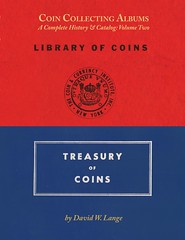 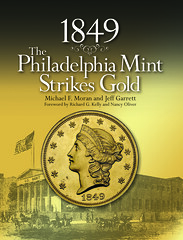 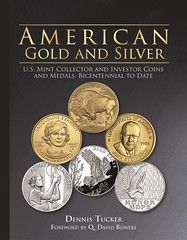
Regulars Julian Leidman, Joe Leidman and Gene Brandenburg were unable to make it. Seated across from me and Eric were Dave Schenkman and Jon Radel. To my right was Robert Hoppensteadt. Other attendees included Tom Kays, Joe Esposito, Lenny Goldberg, our host Aaron Packard, Steve Bishop, Mike Packard and Wayne Herndon. My companions brought along a great range of interesting material for display, and they kindly shared images and descriptions. So I'm turning the rest of my diary over the them, the numismatic mavens of the evening. Eric Schena: Bank of Virginia $50 Note
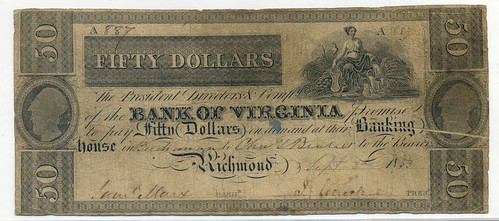
Eric's 1859 Bank of Virginia $50 note is a rare issued example of a higher-denomination note. Most genuine higher-denomination notes got redeemed, leaving for collectors only printer's proofs and counterfeits. Eric adds: The note I brought was issued by the Bank of Virginia's branch in Buchanan in Botetourt County just northwest of Roanoke. Some of the bigger Virginia banks had branch offices throughout the state, even though the notes themselves were numbered and signed at the "mother" bank. This note is interesting in that it has a printed fold plus was formerly in the John J. Ford, Jr. collection. Jon Radel: Medals of the Guild of Medallic Art in Finland
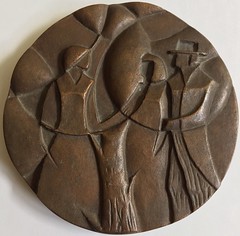
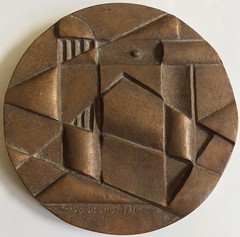
Juhlavuosi (Anniversary) by Toivo Pelkonen 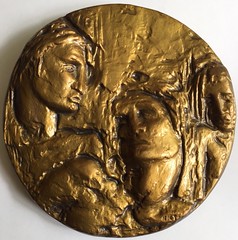
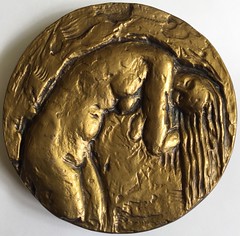
Elämää (Life) by Hannele Kylänpää Jon writes: I brought two medals from the annual series of the Suomen Mitalitaiteen Kilta – Gillet för Medaljkonst i Finland ( The Guild of Medallic Art in Finland) founded in 1965. The competitions also started in 1965, and given the prominence of the organization, for at least some of its history the patron was the president of Finland (I'm unclear on the current status), many prominent artists have participated. The first medal is by Toivo Pelkonen, Juhlavuosi (Anniversary), the winner of the 1975 competition. 121 mm / 1070 g. The second medal is by Hannele Kylänpää, Elämää (Life), the winner of the 1976 competition. 115 mm / 970 g. The guild's old website is still up with a listing of all the winners through 2000 at http://www.kolumbus.fi/mitalitaide/yearmedals.html. More recent medals can be seen on their current website, though I find the photos less satisfactory, at http://mitalitaide.fi/?page_id=666. A good starting point for more information, particularly for those who don't read Finnish, is at http://mitalitaide.fi/?page_id=28. Steve Bishop: Medals and An Overstruck 5 Kopecks

Finnish Union of Veterans and War Invalids Medal 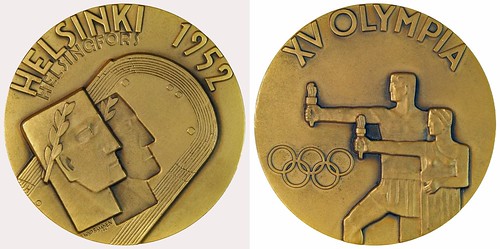
1952 Olympics Particpant Medal by Rasanen 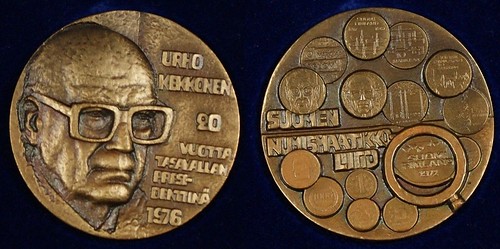
1976 Medal Showing Coins Issued Under Finnish President Urhu Kekkonen 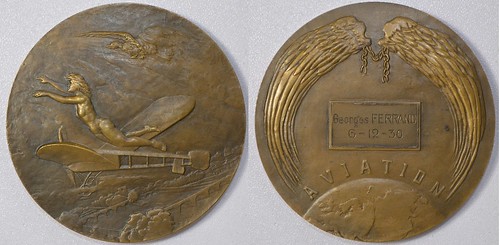
1930 French Aviation Medal to Georges Ferrand I like these Art Deco era aviation medals. They're not all about Lindbergh. 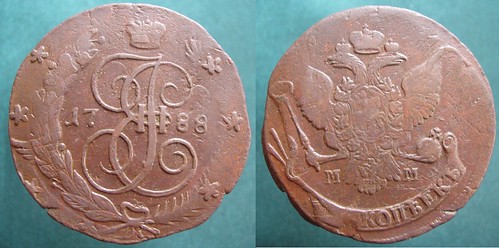
1788 MM 5 Kopecks Overstruck 2 Steve writes: The 5 kopeck piece is a particularly nice example of the type (Catherine 5 kopeck struck over 1762 10 kopeck), because it shows so much of the under-coin. Robert Hoppensteadt: Bronze coin from Caesarea ad Libanum in Phoenicia
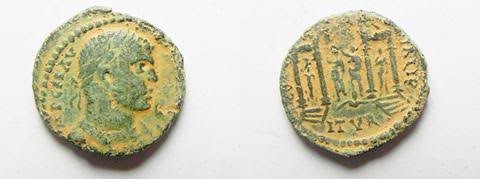
Robert writes: My coin is a small 24mm bronze from Caesarea ad Libanum in Phoenicia. There are only a handful I could find in existence and this is the nicest one of the 8 or so that were located. The obverse is a laureate bust of Severus Alexander, the reverse is a tetrastyle temple, in the center is a statue of Astarte being crowned by an unknown male figure in military garb (possible Severus) with a river god swimming at their feet, one other female statue stands in each wing with a stairs leading up to them. Interesting architectural type, possibly minted in celebration of Severus Alexander's ascension to the throne as he was born in this town in 208. One source had enough of an obverse inscription to note this was struck for Severus as Caesar, which would have been over only a few days in March 11-14th (or until the town was informed of his being made emperor) - can't make that out on this piece as it would have been on the right side of his bust and the other known pieces are not readable either but given the rarity it is possible they were only struck for a very short time. I too, like ancient coins featuring architecture, but have never collected them. Nice piece. Joe Esposito: Upton Sinclair Satire Note
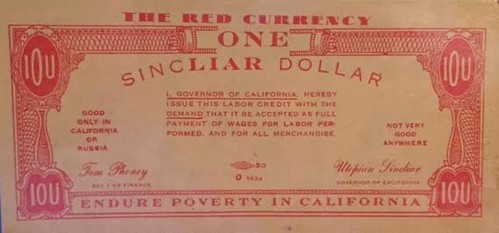

Joe writes: Upton Sinclair (1878-1968) was a prolific novelist, but was best known for books which called attention to the power of big business and the plight of the common worker in the early twentieth century. Perhaps his most notable book was The Jungle, about the Chicago meatpacking industry. He also was politically active as a socialist and Democrat in California in the 1920s and 1930s. Sinclair was the Democratic nominee for governor of California in 1934, promoting a program he called End Poverty in California (EPIC). He was defeated at least in part because of his socialist agenda. Among the attacks on him was the “SINCLIAR DOLLAR.” Some amusing aspects: 1. It is printed in red and identified as “The Red Currency,” referring to the Soviet Union and communism. 2. It is “signed by” Utopian Sinclair,” and “Tom Phoney.” 3. Because his running mate was Sheridan Downey, the currency was “issued” by “Uppy” (Sinclair) and “Downy.” 4. It states that it is “Redeemable if ever at the cost of future generations.” 5. The money was “good only in California or Russia,” but “not very good anywhere.” Tom Kays: Washington Medal
 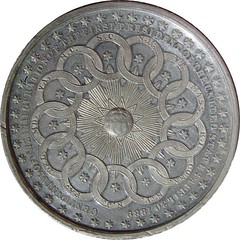
Tom writes: The Washingtonia piece I brought is a Douglas 52-a from the Centennial of George Washington's “First” Inauguration, celebrated in 1889. From Joe Esposito's forthcoming article in the Spring 2016 edition of The Virginia Numismatist we know it is: “… a work from dies originally done by Charles Cushing Wright (1796-1854)…The obverse reflects the bust done of Washington by Jean-Antoine Houdon in the late 1780s or 1790s. The portrait is also the basis for the current Washington quarter by John Flanagan. But the real beauty of this 54-mm medal is the reverse. Here there are thirteen interlocking state rings, signifying the unity of the new nation in 1789. In the middle is a radiating sun. The design is a more elaborate rendering of the reverse of the Fugio Cent, which states in the center: “WE ARE ONE.” This medal is known as “Thirteen Links.” It is interesting that the medal has forty-two stars on the obverse while the Saint-Gaudens has thirty-eight. The reason is that four states—North Dakota, South Dakota, Montana and Washington—were added to the Union in November 1889. Saint-Gaudens' work preceded the Wright/Chapman medal.” Thanks to Joe Esposito for this description. And More...
Tom Kays supplied these images of other items that graced our table. 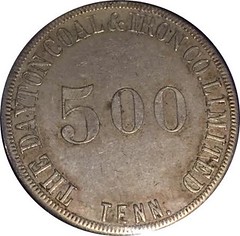 
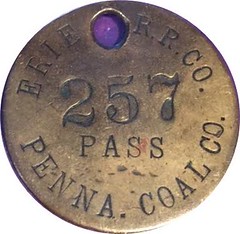
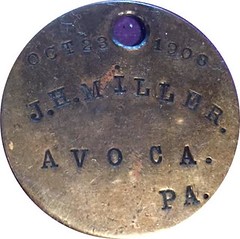
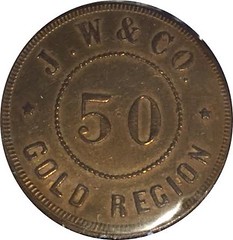 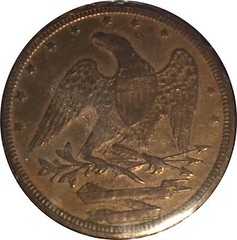
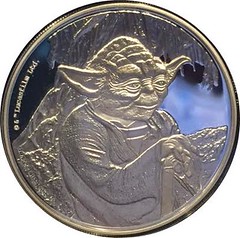
Tom adds: I sat by Wayne Herndon who told me his mass marketing strategy for much of the evening which was an eye-opener about the business that happens over coin show tables, behind the table at coin shows, after the show, and on the Internet where much of the profits really come in. Dealing in hobby supplies is a lot different than dealing in coins. Wayne drives a truck and trailer to shows sometimes with 12 tons of Wizard coin supplies. He may come home with 11 tons after a good show but with dealer business cards listing item volume amounts for direct shipping of tons more supplies the next week from the vast Wizard Coin Supply warehouse. With over 100,000 different Internet purchasers, many beyond the numismatic hobby, his is an entrepreneurial niche on a scale we can only guess. My beer got warm before I finished it. I switched to soft drinks. Dinner was good. I visited with Tom Kays, Joe Esposito and Wayne Herndon before heading home around 9 o'clock. As always, it was a fun night of numismatic fellowship. Looking forward to next time! 
Wayne Homren, Editor The Numismatic Bibliomania Society is a non-profit organization promoting numismatic literature. See our web site at coinbooks.org. To submit items for publication in The E-Sylum, write to the Editor at this address: whomren@gmail.com To subscribe go to: https://my.binhost.com/lists/listinfo/esylum All Rights Reserved. NBS Home Page Contact the NBS webmaster 
|